Washington State Ferries
Washington State Ferries (WSF) is a government agency that operates automobile and passenger ferry service in the U.S. state of Washington as part of the Washington State Department of Transportation. It runs ten routes serving 20 terminals located around Puget Sound and in the San Juan Islands, designated as part of the state highway system. The agency maintains the largest fleet of ferries in the United States at 23 vessels, carrying 24.2 million passengers in 2016.[1] As of 2016, it was the largest ferry operator in the United States,[2] and the fourth-largest ferry system in the world.[1]
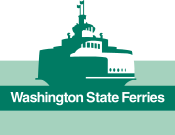 | |
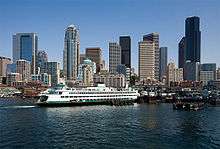 | |
| Locale | Washington |
|---|---|
| Waterway | Puget Sound, Salish Sea |
| Transit type | Ferry |
| Owner | Washington State Department of Transportation |
| Operator | Washington State Department of Transportation |
| Began operation | June 1, 1951 |
| No. of lines | 10 |
| No. of vessels | 21 |
| No. of terminals | 20 |
| Daily ridership | 61,745 (2013) |
| Website | wsdot.wa.gov/ferries |
History
The ferry system has its origins in the "mosquito fleet", a collection of small steamer lines serving the Puget Sound area during the later part of the nineteenth century and early part of the 20th century. By the beginning of the 1930s, two lines remained: the Puget Sound Navigation Company (known as the Black Ball Line) and the Kitsap County Transportation Company. A strike in 1935 forced the KCTC to close, leaving only the Black Ball Line.[3]
Toward the end of the 1940s the Black Ball Line wanted to increase its fares, to compensate for increased wage demands from the ferry workers' unions, but the state refused to allow this, and so the Black Ball Line shut down. In 1951, the state bought nearly all of Black Ball's ferry assets for $5 million (Black Ball retained five vessels of its fleet).[4] The state intended to run ferry service only until cross-sound bridges could be built, but these were never approved, and the Washington State Department of Transportation runs the system to this day.
In 2017, the Senate Labor, Commerce and Sports Committee held a fact finding hearing in Olympia in response to a report from KING-TV which analyzed the past five years of WSF financial data obtained through a request for public records. Transportation officials issued a statement saying, "the cash-strapped ferry system was cutting out excessive forms of compensation for many of its workers and saving millions of tax dollars in the process," while KING 5 Investigators showed WSF has been spending more on labor costs every year since 2012. Sen. Michael Baumgartner, R-Spokane, chair of the committee, said, "the most troubling portion of the report centered on how types of compensation that were eliminated by the legislature and WSF management were quietly added back on, which led to the soaring labor costs." Baumgartner stated plans to introduce legislation that would make negotiating contracts an open process in the future. He cited a conflict of interest in the current protocol as labor unions are perennial supporters of the governor.[5][6]
Routes
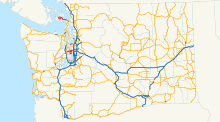
| Route name | Terminals | State route designation[7] | Annual Ridership[8] | Annual Vehicles Carried[8] | Notes | |||
|---|---|---|---|---|---|---|---|---|
| Anacortes–Sidney BC | Sidney, British Columbia | Friday Harbor, San Juan Island | Anacortes | 123,001 | 42,589 |
| ||
| Anacortes–San Juan Islands | Friday Harbor, San Juan Island | 2,009,438 | 947,064 |
| ||||
| Lopez Island | ||||||||
| Shaw Island | ||||||||
| Orcas Island | ||||||||
| Interisland | Friday Harbor, San Juan Island | Orcas Island | Shaw Island | Lopez Island |
| |||
| Port Townsend–Coupeville | Port Townsend | Coupeville, Whidbey Island | 819,285 | 372,130 |
| |||
| Mukilteo–Clinton | Clinton, Whidbey Island | Mukilteo | 4,073,761 | 2,234,650 | ||||
| Edmonds–Kingston | Kingston | Edmonds | 4,114,181 | 2,127,315 | ||||
| Seattle–Bainbridge Island | Winslow, Bainbridge Island | Seattle (Colman Dock) | 6,429,853 | 1,929,617 | ||||
| Seattle–Bremerton | Bremerton | Seattle (Colman Dock) | 2,739,926 | 673,815 | ||||
| Fauntleroy–Vashon | Vashon Island | West Seattle (Fauntleroy) | 3,059,587 | 1,738,721 |
| |||
| Fauntleroy–Southworth | Southworth | West Seattle (Fauntleroy) | ||||||
| Southworth–Vashon | Southworth | Vashon Island | 200,672 | 109,548 | ||||
| Point Defiance–Tahlequah | Tahlequah, Vashon Island | Tacoma (Point Defiance) | 812,786 | 473,924 | ||||
Fleet
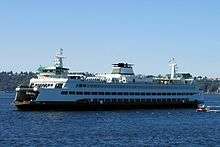
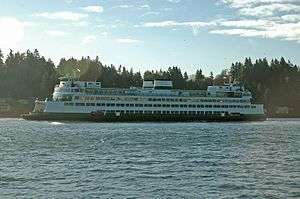
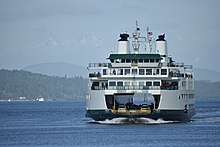
As of April 17, 2020, there are 21 ferries on Puget Sound operated by the state.[9] The largest vessels in this fleet carry up to 2500 passengers and 202 vehicles. They are painted in a distinctive white and green trim paint scheme, and feature double-ended open vehicle decks and bridges at each end so that they do not need to turn around.[10]
The ferry fleet consists of the following vessels:[9]
| Ferry Name | Class | Year Built (Rebuilt) | Auto Capacity | Passenger Capacity | Speed (knots) | Notes |
|---|---|---|---|---|---|---|
| MV Tillikum | Evergreen State | 1959 (1994) | 87 | 1061 | 13 | |
| MV Kaleetan | Super | 1967 (2005) | 144 | 2000 | 17 | |
| MV Yakima | Super | 1967 (2005) | 144 | 2000 | 17 | |
| MV Spokane | Jumbo | 1972 (2004) | 188 | 2000 | 18 | |
| MV Walla Walla | Jumbo | 1973 (2003) | 188 | 2000 | 18 | |
| MV Issaquah | Issaquah 130 | 1979 (1989) | 124 | 1200 | 16 | Auto capacity increased in 1989. |
| MV Kitsap | Issaquah 130 | 1980 (1992) | 124 | 1200 | 16 | Auto capacity increased in 1992. |
| MV Kittitas | Issaquah 130 | 1980 (1990) | 124 | 1200 | 16 | Auto capacity increased in 1990. |
| MV Cathlamet | Issaquah 130 | 1981 (1993) | 124 | 1200 | 16 | Auto capacity increased in 1993. |
| MV Chelan | Issaquah 130 | 1981 (2005) | 124 | 1076 | 16 | Upgraded to meet SOLAS standards for Sidney, BC route in 2005. Auto capacity increased in 2001. |
| MV Sealth | Issaquah 100 | 1982 | 90 | 1200 | 16 | |
| MV Tacoma | Jumbo Mark II | 1997 | 202 | 2500 | 18 | |
| MV Wenatchee | Jumbo Mark II | 1998 | 202 | 2500 | 18 | |
| MV Puyallup | Jumbo Mark II | 1999 | 202 | 2500 | 18 | |
| MV Chetzemoka | Kwa-di Tabil | 2010 | 64 | 750 | 15 | |
| MV Salish | Kwa-di Tabil | 2011 | 64 | 750 | 15 | |
| MV Kennewick | Kwa-di Tabil | 2011 | 64 | 750 | 15 | |
| MV Tokitae | Olympic | 2014 | 144 | 1500 | 17 | |
| MV Samish | Olympic | 2015 | 144 | 1500 | 17 | |
| MV Chimacum | Olympic | 2017 | 144 | 1500 | 17 | |
| MV Suquamish | Olympic | 2018 | 144 | 1500 | 17 |
Retired vessels
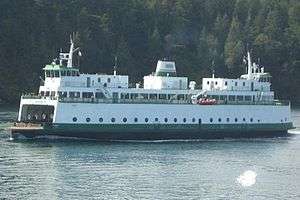

Since the beginning of state-run ferry service in 1951, WSF has retired many vessels as they have become older, too expensive to operate or maintain, or have become too small to provide adequate ferry service. WSF owned passenger-only vessels between 1985 and 2009, but after discontinuing its two passenger-only routes in the 2000s, WSF has sold its passenger-only ferries to other operators.
Below is a list of ferries that WSF has retired since 1951. Unless otherwise noted, all vessels introduced in 1951 were acquired from the Puget Sound Navigation Company (PSN), also known as the Black Ball Line, when the state took over the company's routes and ferryboats in Puget Sound.
| Ferry Name | Class | Year Built (Rebuilt) | Year in service | Year Retired | Auto Capacity | Passenger Capacity | Notes |
|---|---|---|---|---|---|---|---|
| MV Chippewa | None | 1900 (1928/ 1932) | 1951 | 1964 | 52 | 950 | Converted to a car ferry in 1926 |
| MV Leschi | None | 1913 | 1951 | 1967 | 40 | 453 | Previously owned by King County and used on Lake Washington |
| SS San Mateo | None | 1922 | 1951 | 1969 | 50 | 659 | Purchased by PSN in 1941 |
| SS Shasta | None | 1922 | 1951 | 1958 | 55 | 468 | Purchased by PSN in 1941 |
| MV Rosario | None | 1923 (1931) | 1951 | 1951 | 33 | 312 | |
| MV Kitsap (1925) | Anderson | 1925 | 1951 | 1961 | 32 | 325 | |
| MV Crosline | None | 1925 (1947) | 1951 | 1967 | 30 | 300 | Purchased by the state in 1947 |
| MV Kehloken | Wood Electric | 1926 | 1951 | 1972 | 50 | 770 | Purchased by PSN in 1940 |
| MV Kalakala | None | 1926 (1935) | 1951 | 1967 | 110 | 1943 | Originally built as MV Peralta in 1926; rebuilt as Kalakala in 1935 using Peralta's hull |
| MV Enetai | Steel Electric | 1927 | 1951 | 1967 | 90 | 1500 | Purchased by PSN in 1940 and converted to a single-ended ferry |
| MV Willapa | Steel Electric | 1927 | 1951 | 1967 | 90 | 1500 | Purchased by PSN in 1940 and converted to a single-ended ferry |
| MV Chetzemoka (1927) | Wood Electric | 1927 | 1951 | 1973 | 50 | 400 | Purchased by PSN in 1938 |
| MV Quinault | Steel Electric | 1927 (1958/ 1985) | 1951 | 2007 | 59 | 616 | Purchased by PSN in 1940 |
| MV Illahee | Steel Electric | 1927 (1958/ 1986) | 1951 | 2007 | 59 | 616 | Purchased by PSN in 1940 |
| MV Nisqually | Steel Electric | 1927 (1958/ 1987) | 1951 | 2007 | 59 | 616 | Purchased by PSN in 1940 |
| MV Klickitat | Steel Electric | 1927 (1981) | 1951 | 2007 | 64 | 412 | Purchased by PSN in 1940 |
| MV Klahanie | Wood Electric | 1928 | 1951 | 1972 | 50 | 601 | Purchased by PSN in 1940 |
| MV Skansonia | None | 1929 | 1951 | 1969 | 32 | 465 | Operated under a state contract since 1940 after the Tacoma Narrows Bridge collapsed |
| MV Vashon | Anderson | 1930 | 1951 | 1980 | 50 | 646 | |
| MV Olympic | None | 1938 | 1954 | 1993 | 55 | 605 | Purchased by WSF in 1954 |
| MV Rhododendron | None | 1947 (1990) | 1954 | 2012 | 48 | 546 | Purchased by WSF in 1954, sold to Atlantic Capes Fisheries in 2013 |
| MV Evergreen State | Evergreen State | 1954 (1988) | 1954 | 2016 | 87 | 854 | |
| MV Kulshan | None | 1954 | 1970 | 1982 | 65 | 350 | Purchased by WSF in 1970, sold in 1982 and renamed MV Governor |
| MV Klahowya | Evergreen State | 1958 (1995) | 1958 | 2017 | 87 | 792 | |
| MV Hyak | Super | 1966 | 1967 | 2019 | 144 | 2000 | |
| MV Hiyu | None | 1967 | 1967 | 2016 | 34 | 199 | |
| MV Elwha | Super | 1967 (1991) | 1968 | 2020 | 144 | 1069 | Upgraded to meet SOLAS standards for Sidney, BC. |
| MV Tyee | None | 1985 | 1985 | 2003 | 0 | 250 | Operating as M/V Glacier Express in Kenai Fjords National Park, Alaska as of 2013[12][13] |
| MV Kalama | Skagit/Kalama | 1989 | 1989 | 2009 | 0 | 230 | Sold in 2011 |
| MV Skagit | Skagit/Kalama | 1989 | 1989 | 2009 | 0 | 230 | Sold in 2011; capsized on July 18, 2012 |
| MV Chinook | Passenger-Only Fast Ferry | 1998 | 1998 | 2008 | 0 | 350 | Sold to Golden Gate Ferries, renamed MV Golden Gate |
| MV Snohomish | Passenger-Only Fast Ferry | 1999 | 1999 | 2008 | 0 | 350 | Sold to Golden Gate Ferries, renamed MV Napa |
Other ferries
There are several other publicly operated, private, and passenger-only ferries in Washington state.
See also
- Alaska Marine Highway
- BC Ferries
- Black Ball Line
- Ferries in Washington State
- Inter-Island Ferry Authority
- Keller Ferry
- King County Water Taxi
- Seattle tugboats
References
- "Washington State Ferries - Traffic Statistics Rider Segment report - Jan 1, 2016 thru Dec 31, 2016" (PDF). Washington State Department of Transportation. January 23, 2017. Retrieved February 1, 2017.
- WSDOT Ferries Division, Washington State Department of Transportation, December 2016. Archived from the original on December 14, 2019.
- History of Washington State Ferry system, wsdot.com, retrieved March 15, 2008
- Washington State Ferries begins operations on June 1, 1951, HistoryLink.org, retrieved March 15, 2008
- Frame, Susannah. "Lawmakers act on KING 5 investigation into ferry system spending spree". KING. Retrieved 2018-06-08.
- Frame, Susannah. "Whopping pay raises on deck for some ferry workers". KING. Retrieved 2018-06-08.
- 2004-2005 Official State Highway Map, Washington State Department of Transportation, retrieved March 15, 2008
- "WSDOT Ferries Division- overview and fact sheet" (PDF). Washington State Department of Transportation. January 2017. Retrieved May 25, 2017.
- Washington State Ferries - Our Fleet, Washington State Department of Transportation, Retrieved June 16, 2020
- "WSDOT Ferries Division Fleet Guide" (PDF). Washington State Department of Transportation. October 2018. Retrieved November 28, 2018.
- "The Ghost Fleet of Washington State Ferries". EvergreenFleet.com. Retrieved 5 November 2012.
- M/V Tyee, Evergreen Fleet, retrieved 2013-06-28
- Our fleet of vessels, Major Marine Tours, retrieved 2013-06-28
External links
| Wikimedia Commons has media related to Washington State Ferries. |